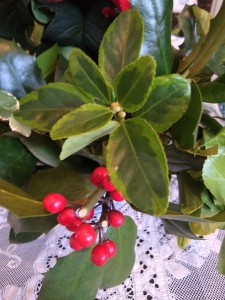 I am having a bad case of holiday envy. As I walk my neighborhood, I see that my neighbors have spent the past weekend arranging extravagant holiday displays. Twinkly lights sparkle from trees and shrubs, wreathes adorn multiple windows, over-the-door arches welcome visitors to various homes, and holiday inflatables of every size and description sway on front lawns. One house in my town has jumped aboard the inflatable bandwagon, with two giant Christmas dragons that must be at least seven feet tall, complete with Christmas hats and candy canes clutched in their air-filled claws.
I am having a bad case of holiday envy. As I walk my neighborhood, I see that my neighbors have spent the past weekend arranging extravagant holiday displays. Twinkly lights sparkle from trees and shrubs, wreathes adorn multiple windows, over-the-door arches welcome visitors to various homes, and holiday inflatables of every size and description sway on front lawns. One house in my town has jumped aboard the inflatable bandwagon, with two giant Christmas dragons that must be at least seven feet tall, complete with Christmas hats and candy canes clutched in their air-filled claws.
I am already behind, but there is nothing like envy to motivate even a decorating slacker like me. I am not made of money, but I do have resources. Every day I defeat my innate laziness by making games out of chores, and I will do the same with Christmas decorating. I’ll get to the garden center sooner rather than later, so I have supplies at the ready whenever I have ten minutes to deck my halls.
Most important, I’ll use what I have growing on the premises—an awful lot of holly, false holly and euonymus–to drape over all the available surfaces. It costs nothing and most of the shrubs need pruning anyway. One of my ways of gaming the holiday decorating system is to make a virtue—holiday decorations—out of the necessity of pruning.
Why is holly such a big deal in holiday decorating? It all goes back to our ancient forbearers, especially those living in cold winter climates, who thought anything that stayed green over the winter had magical properties. The Romans, ever a fun-loving group—at least when they weren’t out conquering things—used evergreens to celebrate Saturnalia, a winter celebration that included the exchange of gifts and masters temporarily swapping roles with slaves. Ancient Celts hung holly, along with other greens, as well. When Christianity came along, holly, with its prickly leaves, was adopted as a symbol of Christ’s crown of thorns. The red berries represented his blood.
No matter what holly symbolizes for you, it is great for holiday and winter decorating. The leaves are glossy and eye-catching and the berries are little points of light that are especially welcome in a month when stygian darkness envelopes the outdoor world from about four-thirty every afternoon to about eight-thirty the next morning.
If you have a little room on your property, you can grow enough holly to create your own decorations or augment store-bought swags and wreathes. Before investing in one, remember that with hollies, everything comes down to sex. Hollies are either male or female, and you need both so that the female plants can produce berries. Fortunately, the male plant does not have to live on your lot—it can belong to a neighbor or someone on your block. The bees do the heavy lifting. Male hollies often have masculine-sounding names, like ‘Blue Prince’. Female hollies sometimes have feminine names. If you are in doubt, ask someone knowledgeable at your local nursery. Catalog and online vendors usually supply this important information as well.
Good old English holly or Ilex aquifolium is justly renowned for its glossy green leaves and abundant red berries. It is quite amenable to clipping and can be left to its own devices, or disciplined into standard tree form. Prune regularly to keep the plant at a manageable size for your situation.
English holly is also available in gorgeous variegated forms and I have seen more of them in home landscapes lately. ‘Argenteomarginata’ is a female variety, featuring cream leaf margins that may turn a bit rosy under certain weather conditions. ‘Aureomarginata’ boasts golden yellow leaf margins.
The English hollies have been widely hybridized, and if you live in a climate with colder winters, you might try one of the Meserveae hybrids, which were the result of crosses made between English hollies and a cold-hardy species, Ilex rugosa. Among the best known are ‘Blue Boy’ and ‘Blue Girl’, both with dark, lustrous blue-green foliage.
‘Nellie Stevens’ is another popular hybrid holly that forms a relatively compact tree, topping out at about 25 feet. ‘Nellie’ is distinguished by the fact that it can reproduce parthenocarpically or without pollination by a male plant. This means red berries will appear even without the intervention of a local male holly.
If you have made a commitment to native plants, try American holly or Ilex opaca. The leaves on the species are a little less showy and shiny than those of English holly. You can compensate for that by buying varieties like ‘Jersey Knight’ and ‘Jersey Princess’, which have been selected for heavy berry production and attractive leaves. Ilex iconoclasts may choose the striking ‘Canary’, which bears yellow fruits. After all, lightening will not strike you if your holiday swags are adorned with golden berries.
If you, like me, suffer from holiday decoration envy, or just want a lovely, wildlife-friendly plant for your yard or garden, investigate the holly clan. Local nurseries usually carry several varieties and can advise you about the best varieties and planting times. For a mail order/online source, try ForestFarm, 14643 Watergap Rd, Williams, OR 97544; (541) 846-7269; www.forestfarm.com.
